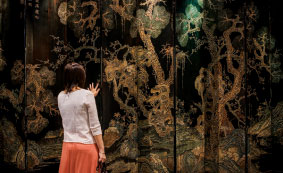Poly plans to bring out heavy-weight masterpieces such as ink paintings by Zhang Daqian, and oil paintings by Chu The-chun, as well as a series of fine jewelry by Chinese designer Chen Shiying.
China Guardian offered 319 pieces of Chinese painting and calligraphy for its first auction in Hong Kong, selling 85 percent of them, and totaled HK$354 million, almost three times previous estimates. The antique furniture auction that followed sold all but three of the 39 offered pieces.
"This is our first auction outside the boundary of the Chinese mainland," Wang Yannan, president of China Guardian, told the media. "The success greatly boosted our confidence. We plan to make long-term investment and development in Hong Kong and hold regular spring and autumn auctions annually."
|
 A visitor looks at a coromandel Chinese lacquer from the Qing Dinasty Kangxi period at a fine art fair in Kong Kong. [Photo/Agencies] |
By placing fine jewelry and modern oil paintings in its inaugural sale's catalogue, Poly has posed direct challenge to foreign counterparts of Sotheby's and Christie's.
"We have registered an independent company in Hong Kong and plan to develop steadily here," Zhao said. "We have a permanent office in Hong Kong and an international team of experts there. The operational cost is high, but we are determined to make it."
China's art market boomed with its economy since the mid 2000s, and auction companies on the mainland emerged and developed rapidly with it. A Xinhua report citied statistics from Artprice.com that China, in 2011, became the world's largest art market, representing more than 40 percent of global art sales.
Beijing has been the art trading center of the mainland, with China Guardian and Poly playing the leading roles. China doesn't allow foreign auction houses like Sotheby's and Christie's to trade on the mainland unless they have a Chinese partner.
"In the recent years, mainland auction companies surpassed their international counterparts in Hong Kong more than once, and they have nurtured a stable group of newly wealthy collectors," said Cao Junjie, an art market commentator based in Shanghai.
China's auction companies are young compared to their western counterparts. China Guardian is arguably the most established art dealer on the mainland. It's been doing business since 1993. Poly Auctions is a member of the China Poly Group, an State-owned enterprise whose core business is international trade and real estate.
Sotheby's and Christie's enjoy history and prestige in Hong Kong, maintaining high operational standards and have become the mature market norm. But Chinese auction companies are catching up quickly.
A Sotheby's staff member used to complain to 21st Century Business Herald that while Sotheby's had to go through many obstacles to enter the mainland market, mainland companies have landed in the Hong Kong market easily.
As a free port, Hong Kong has its duty free advantages and that has played an important part shaping the city's role in the art market. "But if you bring the purchase to the mainland, you are subject to taxation - which can be as high as 26 percent of the purchase price," said Zhao Yong, president of Hosane, a Shanghai-based auction company. "In the long run, this will be a problem."
Christie's has been accused of smuggling by declaring extremely low prices for clients to customs, so they could pay lower taxation when entering the mainland.
Shanghai has played a smaller role in the art market, so far, in comparison to Beijing and Hong Kong, but the city surely has more to offer, Zhao concluded. "The Yangtze Delta has nurtured rich culture in the past centuries, and Shanghai developed an active art market as early as the 1930s. There are loads of treasures hidden among private collections in Shanghai, as well as the neighboring provinces of Zhejiang and Jiangsu. "It takes longer to establish a healthy market ecology, and build trust with collectors."
"Fine art is an extremely scarce resource, and auction talents even more so," said Zhao with Poly. "If we find skilled staff and the right opportunity, we'd like to expand our auction to Shanghai."
Sotheby's established a joint venture in Beijing, Sotheby's (Beijing) Auction Co Ltd. The company has teamed up with Gehua Cultural Development Group, an SOE. The first auction was held on Sep 27, with only one piece on offer, a conceptual sculpture by contemporary artist Wang Huaiqing.
Christie's however, doesn't have any partners on the mainland. It has authorized the Beijing-based Forever International Auction Co to use the trademark of Christie's.
